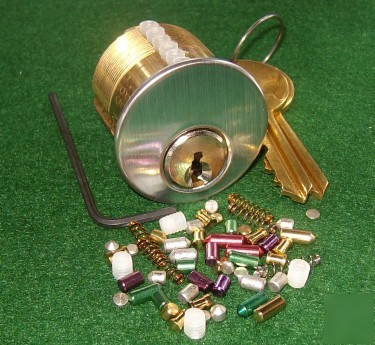Quiet Electronics Moderated Newsgroup For The Electronic Professionals and Other Professionals > Delaware
> New
> Easy to re-pin locksmith practice lock - not a cut away
Easy to re-pin locksmith practice lock - not a cut away
The EZ to re-key Ultimate Practice Lock
- The practice lock with thousands of combinations -
The practice lock cylinder that
Pin stack retainer screws so you can re-key this cylinder over and over again to thousands of different key combinations. An assortment of extra bottom pins, top pins, master pins, and springs is included. For the locksmith in training, this practice lock takes the place of dozens of regular lock cylinders.
Cut away locks are great if you’re having trouble understanding what happens inside a lock. Once you understand what all the parts of a lock do, it’s time to move up to the ultimate practice lock. Unlike cutaway locks, this practice cylinder turns in both directions, the pins won't fall out of the plug, and it feels and behaves like the locks you will find in the real world.
This practice lock cylinder can be pinned with only one or two pin stacks leaving the remaining pin stacks empty. Most training guides recommend starting with one or two pin stacks before advancing to a full cylinder.
difficult pin arrangements for teh advanced picker
More Advanced Key Combinations
As your skills increase, you can add pin stacks up to a total of six. The assortment of pins that are included will allow you to create much more secure keying combinatins such as a difficult-to-reach-around long first pin or a secure hi-lo-hi-lo-hi-lo pin arrangement. The pin assortment also includes master pins to let you create multiple shear lines like those found in many commercial and institutional locks.
Once you have fully understand “regular†locks, you can move up to pick resistant cylinders. Special security pins are becoming more common in locks every year. A decade ago, security pins were a rarity. Today, even cheap hardware store brands include security pins to make them resistant to picking.
spool pinsAn assortment of spool pins (security pins) is also included with this practice cylinder to help you to develop the highest level of skill.
Learn to recognize the false set when a spool pin binds at the shear line. The best way to learn learn spool pins is to put a spool pin in only one pin stack until you have developed the sensitive touch necessary. With this practice cylinder and lots of practice, you can work your way up to pinning locks with spool pins in all 6 pin stacks.
* The cylinder comes pinned with 5 loaded pin stacks. That’s 5 bottom pins of different lengths, 5 top pins, and 5 springs. The cylinder is drilled for up to 6 pin stacks.
* Also included are approximately 25 additional top, and bottom pins of varying length.
* Additional springs are also included in two different lengths. Short springs are to be used with tall pin stacks and long springs are to be used with short pin stacks.
* Enough master pins are included to have at least one master pin in each stack so you can learn institutional key systems.
* Most pick resistant locks only use spool pins in a few pin stacks but we’re including at least 6 spool pins to allow a security pin to be added to each pin stack for the ultimate challenge.
The assortment of pins will vary with each cylinder. We grab a few of this and a few of that and don’t spend much time counting other than to make sure you have at least the number of pins listed above. Typically there will be somewhere around 40 to 50 different pins with each lock. That’s enough for thousands of combinations.
Instructions for repining and training tips are included.
This ultimate practice lock doesn’t require the usual disassembly, plug followers, tweezers, or fighting with pins and springs in such a tiny space that other lock cylinders require. This lock cylinder has been modified so that each pin stack can be accessed from the top by removing a retaining screw. A hex wrench for removing these screws is included. Changing a pin stack is as easy as removing the screw and dumping the existing pin stack in your hand. A new pin stack is dropped in pin by pin. Bottom pin first, master pins if desired, a top pin or spool pin, and the spring. Finally the retainer screw is replaced. Nylon retainer screws protect the soft brass cylinder threads from getting damaged if a screw is cross threaded. Extra retainer screws are included.
* The lock cylinder being sold is exactly like the mortise cylinder shown in the first picture at the top of this description. Key way is the popular YALE GA key way.

